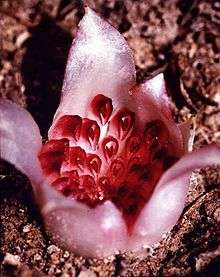Rhizanthella
| Underground orchid | |
|---|---|
 | |
| Rhizanthella gardneri | |
| Scientific classification | |
| Kingdom: | Plantae |
| Clade: | Angiosperms |
| Clade: | Monocots |
| Order: | Asparagales |
| Family: | Orchidaceae |
| Subfamily: | Orchidoideae |
| Tribe: | Diurideae |
| Subtribe: | Rhizanthellinae |
| Genus: | Rhizanthella R.S.Rogers |
| Type species | |
| Rhizanthella gardneri R.S.Rogers (1928) | |
| Species | |
| |
| Synonyms[1] | |
|
Cryptanthemis Rupp | |
Rhizanthella, commonly known as underground orchids, is a genus of three species of flowering plants in the orchid family, Orchidaceae and is endemic in Australia. All are leafless, living underground in symbiosis with mycorrhizal fungi. The inflorescence is a head of flowers held at, or just above the ground but mostly covered by soil or leaf litter and little is known about the mechanism of pollination.
Description
Orchids in the genus Rhizanthella are mostly underground, perennial, sympodial, mycotrophic herbs with fleshy underground stems which produce new shoots at nodes where there are colourless leaf-like cataphylls. There are no roots and new tubers form at the end of short stems. The leaves are reduced to scale-like structures lacking chlorophyll, pressed against and sheathing the stems.[2][3][4][5]
The inflorescence is a head containing many flowers and is held at, or just above ground level but the head is usually covered with leaf litter or soil. The head is surrounded by a large number of overlapping bracts and each flower has an erect, elongated bract at its base. The flowers are non-resupinate, arranged in a spiral, inward-facing, dull coloured and lack a stalk. The sepals and petals form a short, curved hood over the labellum and column, open on one side. The lateral sepals are joined to each other and to the dorsal sepal at their bases. The petals are joined at their bases to the column and are shorter than the sepals. The labellum is different in size, shape and colouration from the other petals and sepals, is thick, fleshy and has no nectar. The column is short with short wings. Flowering time depends on species and is followed by the fruit which is a berry that does not split open (indehiscent) and which contains 50 to 100 seeds.[2][3][4][5]
Underground orchids do not possess chloroplasts but they retain plastid genes, although R. gardneri possesses the smallest organelle genome yet described in land plants.[6]
Taxonomy and naming
The first formal description of an underground orchid was by Richard Sanders Rogers who published his description of R. gardneri in Journal of the Royal Society of Western Australia in 1928.[7] The name "Rhizanthella" is a diminutive of Rhizanthes, a parasitic plant in the Family Rafflesiaceae.[8] The name "Rhizanthes" is derived from the Ancient Greek words rhiza meaning "root"[9]:666 and anthos meaning "flower".[9]:338
Distribution and habitat
Rhizanthella gardneri occurs in the south-west of Western Australia where it grows in association with broombush (Melaleuca uncinata).[3] Rhizanthella omissa has only been collected once, at an elevation of 1,200 m (4,000 ft) in the Lamington National Park in Queensland.[10] Rhizanthella slateri, formerly known as Cryptanthemis slateri occurs in the Blue Mountains and similar ranges in New South Wales where it grows in sclerophyll forest.[5]
Ecology
The pollination mechanism of Rhizanthella is not known. A single specimen of a small fly from the genus Megaselia, some small wasps and termites are the only observations of insects carrying pollinia of Rhizanthella.[2]
References
- ↑ "Rhizanthella". World Checklist of Selected Plant Families (WCSP). Royal Botanic Gardens, Kew. Retrieved 20 July 2016.
- 1 2 3 Pridgeon (ed.), Alec M.; Cribb (ed.), Phillip J.; Chase (ed.), Mark W.; Rasmussen (ed.), Finn (2001). Genera Orchidacearum, Volume 2, Orchidoideae (part 1). Oxford, England: Oxford University Press. pp. 186–193. ISBN 0198507100.
- 1 2 3 Hoffman, Noel; Brown, Andrew (2011). Orchids of South-West Australia. (3rd ed.). Gooseberry Hill: Noel Hoffman. pp. 386–389. ISBN 9780646562322.
- 1 2 "Rhizanthella". FloraBase. Western Australian Government Department of Parks and Wildlife.
- 1 2 3 Weston, Peter H. "Genus Rhizanthella". Royal Botanic Garden Sydney: plantnet. Retrieved 20 July 2016.
- ↑ Delannoy, Etienne; Fujii, Sota; Colas des Francs-Small, Catherine; Brundrett, Mark; Small, Ian (2 February 2011). "Rampant Gene Loss in the Underground Orchid Rhizanthella gardneri Highlights Evolutionary Constraints on Plastid Genomes". Molecular Biology and Evolution. 28 (7): 2077–2086. PMC 3112369
 . PMID 21289370. doi:10.1093/molbev/msr028.
. PMID 21289370. doi:10.1093/molbev/msr028. - ↑ "Rhizanthella gardneri". APNI. Retrieved 20 July 2016.
- ↑ Quattrocchi, Umberto (2000). R - Z. Boca Raton, FL: CRC World Dictionary of Pant Names (R-Z). p. 2296. ISBN 0849326788.
- 1 2 Brown, Roland Wilbur (1956). The Composition of Scientific Words. Washington, D.C.: Smithsonian Institution Press.
- ↑ "Rhizanthella omissa". Internet Orchid Species Photo Encyclopedia. Retrieved 20 July 2016.
- George, A. S. (1981). Rhizanthella-The Underground Orchid of Western Australia. Proceedings of the Orchid Symposium, 13th International Botanical Congress 77-78.
- Dixon, K. W., et al. (1990). The Western Australian fully subterranean orchid Rhizanthella gardneri. Orchid Biology, Reviews and Perspectives. V. J. Arditti. Portland, Oregon, Timber Press. 5: 37-62.
- Dixon, K. (2003) Underground Orchids on the Edge. Plant Talk, 31: 34-35.
- Jones, D.L. & Clements, M.A. (2006). Rhizanthella omissa, a new species of underground orchid from south eastern Australia. The Orchadian, vol. 15, no. 3, pp. 131–133.
Further reading
- Jones, David L. (2006). A complete guide to native orchids of Australia: including the island territories. Frenchs Forest. ISBN 1-877069-12-4.
- Underground orchid - Rhizanthella gardneri at ARKive.org (includes photographs)
-
 Media related to Rhizanthella at Wikimedia Commons
Media related to Rhizanthella at Wikimedia Commons -
 Data related to Rhizanthella at Wikispecies
Data related to Rhizanthella at Wikispecies